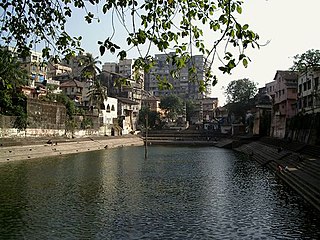Related Research Articles

Malabar Hill is amongst the most affluent residential areas in Mumbai. It is home to several business tycoons and film personalities. Muhammad Ali Jinnah, the founder of Pakistan, had built and lived in a bungalow, called South Court, in Malabar Hill.

Mahalaxmi is an upscale, affluent neighbourhood in the city of Mumbai, India. It is known for Royal Western India Turf Club’s Mahalaxmi Racecourse with horse races every year having visitors from around the world. It is particularly well-known for housing the majestic Mahalaxmi Temple, dedicated to the Hindu goddess of wealth and fortune. Magnificent views can be had of Malabar Hill and the Arabian Sea, two well-known locations.

Although the tanks have long vanished, the city of Bombay once had many water tanks within its city limits. They were once the only source of water to the city. The only testimony to their existence is the names of the roads in their vicinity, which befuddles many citizens as to the original location to these mystifying relics of the past.

Walkeshwar Temple, also known as the Baan Ganga Temple, is a temple dedicated to Lord Shiva located in Walkeshwar, near Malabar Hill neighbourhood, in South Mumbai precinct of the city of Mumbai, India. It is situated at the highest point of the city, and close to the temple lies the Banganga Tank.

The Banganga Tank is a temple tank which is part of the Hindu Walkeshwar Temple complex in the Malabar Hill area of the city of Mumbai, India.

Mumbai has one of the largest populations of Jains among all the cities in India. Mumbai also has numerous Jain temples. One of the best known is the Babu Amichand Panalal Adishwarji Jain Temple, Walkeshwar.
Walkeshwar is an affluent area in South Mumbai, India, at the north-western end of the Marine Drive loop. It has a large Gujarati population. It is mostly known for Walkeshwar Temple, Banganga Tank and Jain temples.

The Shilahara was a royal dynasty that established itself in northern and southern Konkan in 8th century CE, present-day Mumbai and Southern Maharashtra (Kolhapur) during the Rashtrakuta period.

Khar is an affluent suburb of Mumbai, north of Bandra and south of Santacruz, Mumbai. Originally one of the 'villages' that made up the larger Bandra, the present suburb is divided into Khar West and Khar East areas. It is serviced by Khar Road railway station of the Mumbai Suburban Railway network. It is an area within convenient distances of several schools, restaurants, parks, promenades and shopping centres. Khar bears the Mumbai Postal Index Number 400052.
Rama Kamat was a Mumbai (Bombay)-based businessman and philanthropist. The records of his life are scanty. He was connected with the command of Indian troops under the British and had some connections with Kanhoji Angre.

Chiplun ( [t͡ʃipɭuːɳ]) is a city in Ratnagiri district in the state of Maharashtra, India. It is one of the financial and commercial hubs of Ratnagiri district, and the headquarters of Chiplun taluka. It is about 250 km south of Mumbai and 90 km North of Ratnagiri in the Konkan region of Maharashtra, on the Mumbai–Goa highway (NH-66). It has a long history and a strong cultural background. Recent decades have seen much industrial development in it and its and surrounding areas.
Valukeshvara is an epithet of the Hindu deity Shiva.
Bhoom is a town with a municipal council in Dharashiv district, Maharashtra, India, and it is the headquarters of Bhoom tahsil. Bhoom municipal corporation is established in 1948. Bhoom is a small town situated in a valley of the Banashankar hill ranges of Sahyadri. It is situated on the banks of the River Banaganga, which eventually flows into the Bhima. In 1717, Sambhaji II of Kolhapur gave Bhoom as jagir to Shrimant Senakhaskhel Yashwantrao Thorat (a chief and military leader of his troops) for his bravery. In 19th century Bhoom was under Nizam territory during the British raj in India. However it was independently ruled by the ' Thorat ' royal family. Shrimant Vijaysinh Amarsinh Thorat is the present head of Bhoom. He was the President of Bhoom Municipal Council from 1991 -2006.
Banganga Tank is an ancient water tank at Walkeshwar Temple Complex in Malabar Hill area of Mumbai City
The Ancient history of Mumbai recounts the history of Mumbai from 300 BCE to 1348 CE.
Rahul Mehrotra is Founder Principal of architecture firm RMA Architects of Mumbai + Boston, and is Professor of Urban Design and Planning and Chair of the Department of Urban Planning and Design at the Harvard Graduate School of Design (GSD) in Cambridge, Massachusetts.

Grant Road is a locality in South Mumbai.

Tungareshwar Temple is located in Vasai, Palghar District, Maharashtra, India. The temple is dedicated to the Hindu god Shiva, about 3 to 4 kilometres from the "Tungareshwar Entrance Gate", opens at morning 05:00 AM to 06:00 PM. This is a Lord Shiva Temple and also has a Ram Kund on backside area. Alongside the Tungareshwar Temple, a small temple of Goddess "Khodiyaar Mataji". Being said about God and Goddess, Tungareshwar attracts devotees who visit both these temples at special occasions and festival seasons like "Khodiyar Jayanti" which comes in around February and "Maha Shivratri" in Shravana Months as Hindu calendar, falling between July and August every year. Bhandara takes place every year at the "Mahashivratri Festival" and every Monday at the Shravan month.
References
- ↑ Banganga, Walkeshwar history
- ↑ Balasubramanian, Lalitha (30 August 2017). Temples in Maharashtra: A Travel Guide. Notion Press. ISBN 978-1-947697-88-1.